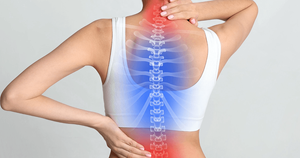Physical Findings
Introduction
Physical signs are sometimes minimal in the early stages of the disease, and the physical examination needs to be comprehensive. This includes a thorough clinical examination of the sacroiliac (SI) joints, assessment of the mobility of the spine (including the neck), chest expansion, range of motion of the hip and shoulder joints, and also a search for signs of enthesitis, peripheral arthritis and associated conditions, such as psoriasis or inflammatory bowel disease (IBD). Clinical signs related to enthesitis that are present in many patients but are often overlooked include tenderness over the SI joints, vertebral spinal processes, spine, iliac crests, anterior chest wall, calcanei (plantar fasciitis and/or Achilles tendinitis), ischial tuberosities, greater trochanters and sometimes the patellae and tibial tubercles.
Pain in the SI joint area may be elicited on firm direct pressure of the joints if there is active sacroiliitis, or by stress testing by using maneuvers…
To continue reading
Log in or register to continue reading. It's free!
OR
By signing up to create an account, I accept Healio's Terms of Use and Privacy Policy.
Introduction
Physical signs are sometimes minimal in the early stages of the disease, and the physical examination needs to be comprehensive. This includes a thorough clinical examination of the sacroiliac (SI) joints, assessment of the mobility of the spine (including the neck), chest expansion, range of motion of the hip and shoulder joints, and also a search for signs of enthesitis, peripheral arthritis and associated conditions, such as psoriasis or inflammatory bowel disease (IBD). Clinical signs related to enthesitis that are present in many patients but are often overlooked include tenderness over the SI joints, vertebral spinal processes, spine, iliac crests, anterior chest wall, calcanei (plantar fasciitis and/or Achilles tendinitis), ischial tuberosities, greater trochanters and sometimes the patellae and tibial tubercles.
Pain in the SI joint area may be elicited on firm direct pressure of the joints if there is active sacroiliitis, or by stress testing by using maneuvers such as the FABERE test (hip Flexion, Abduction, External Rotation and Extension) (Figure 8-1). Sometimes SI pain may be elicited by pressure over the anterior superior iliac spines and compressing the two iliac bones toward each other or forcing them away from each other. Hyperextension of the lumbar spine or hyperextension of one hip joint while applying counter-pressure on the iliac crest by the other hand, with the patient lying supine, can also be painful.
The disease course and outcomes are quite variable in early stages. The typical limitation of spinal mobility and physical deformities usually evolve within 10 years. Important predictors of spinal disease progression are C-reactive protein (CRP), cigarette smoking and baseline presence of syndesmophyte(s). However, in some patients the disease may remain limited to SI joints, and spinal ankylosis may not occur at all. But in most patients, the disease is progressive. With longer disease duration and disease progression, the entire spine becomes increasingly stiff, including the cervical spine. There is also gradual development of accentuated dorsal (thoracic) spinal kyphosis. Clinicians should examine the mobility of the lumbar spine by checking extension, forward flexion, lateral flexion and axial rotation (Figure 8-2).
The modified Schober’s test can be used to evaluate lumbar spine flexibility: with the patient standing, put two marks on the skin over the lumbar area, one at the midline at the level of the posterior superior iliac spine and the other 10 cm higher. Then ask the patient to bend forward as far as possible with the knees fully extended (Figure 8-3 and 8-4).The normal values have not been clearly established for this test; however, if the increase in distance between the marks is ≤3 cm, it indicates diminished flexibility of the lumbar spine. Tenderness and stiffness of the paraspinal muscles often accompany the inflammation of the axial skeleton, and the initial loss of spinal mobility is usually, at least in part, due to pain and muscle spasm rather than bony ankylosis. Therefore, improvement in spinal mobility can occur after control of inflammation and intensive physical therapy.
Tenderness of the anterior chest wall can occur early in the disease course and may be one of the first manifestations in some patients. Tenderness caused by enthesitis may develop at costosternal and manubriosternal junctions and manubrioclavicular joints. Involvement of the costovertebral and costotransverse joints results in restricted chest expansion. A chest expansion (with arms raised above the head) of <2.5 cm at the xiphisternum level (or below the breasts in females) is abnormal and should raise the possibility of ankylosing spondylitis (AS) (unless there is another reason for it, such as emphysema or scoliosis), especially in young patients with a history of chronic low back pain (Figure 8-3). But measures of spinal mobility such as the modified Schober’s test, lateral flexion and hyperextension may be better clinical indicators of AS than chest expansion. One should auscultate the heart looking for the rare occurrence of aortic incompetence and/or heart block.
The hip and shoulder joints, the so-called girdle joints, are affected in 25% to 30% of patients with AS. Hip joint involvement is usually bilateral and insidious in onset; the pain is usually felt in the groin, although in some patients, it is more common when the disease starts at an earlier age. Some degree of contracture of the hip joints is not uncommon at later stages of the disease, giving rise to a characteristic rigid gait. Some patients keep their knees bent a little in order to maintain an erect posture. Figure 8-5 demonstrates how to check for the flexion contracture of the hip joint. Shoulder joint involvement is generally mild and checking for any impairment of range of motion is important. Involvement of the hip joints in a patient with a rigid spine, including the neck, is potentially more crippling and can lead to greater disability, but total hip joint replacement can minimize those limitations. Thigh and buttock muscles may experience atrophy and weakness because of lack of use in some patients, especially with advanced hip joint involvement.
With involvement of the cervical spine, the neck becomes less mobile and that can be elicited by checking cervical lateral flexion, axial rotation and hyperextension. There is also gradual forward stooping of cervical spine that can be quantitated by occiput-to-wall (or tragus-to-wall) distance measurement. Rare involvement of the temporo-mandibular joint can cause tenderness over the joint or some limitation in fully opening the mouth.
Involvement of peripheral joints other than the hips and shoulders is uncommon in “primary” ankylosing spondylitis/ axial spondyloarthritis (AS/axSpA), unless there is associated IBD or Psoriatic Arthritis (PsA). Such involvement is rarely persistent or destructive and tends to resolve without any residual joint deformity. Inflammation can also affect structures adjacent to the joints, such as tendons and bursa, resulting in tendonitis and bursitis.
Spinal ankylosis may progress more slowly in women than in men, but functional outcome, as analyzed by studying activities of daily living, is similar. However, when it comes to pain and the need for drug therapy, female patients tend to be worse off; possibly because of slower (or a relatively incomplete) progression of spinal fusion to result in decrease in inflammatory pain, or the problem of any concomitant fibromyalgia symptoms.
Over the years, there is gradual flattening of the anterior chest wall, shoulders become “stooped,” the abdomen becomes protuberant, and breathing becomes increasingly diaphragmatic. Neurologic complications of AS are uncommon and mostly result from spinal cord injury due to post-traumatic spinal fracture. Spontaneous atlantoaxial subluxation and cauda equina syndrome are rare complications of long-standing disease.





References
- Kahn MA, Akkoç N. Ankylosing Spondylitis— Axial Spondyloarthritis, 3rd ed. Professional Communications Inc. 2023
- Bowie E, Glasgow G. Cauda equina lesions associated with ankylosing spondylitis: report of three cases. Br Med J. 1961;2:24-27.



